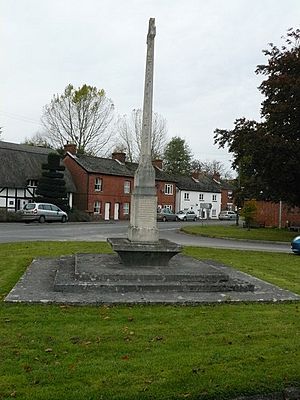King's Somborne War Memorial facts for kids
Quick facts for kids King's Somborne War Memorial |
|
|---|---|
| United Kingdom | |
 |
|
| For men from King's Somborne killed in the First World War | |
| Unveiled | 27 March 1921 |
| Location | 51°04′38″N 1°29′15″W / 51.077201°N 1.487495°W Romsey Road, King's Somborne, Hampshire
near Stockbridge
|
| Designed by | Sir Edwin Lutyens |
|
Listed Building – Grade II
|
|
| Official name | Kings Somborne War Memorial |
| Designated | 7 February 1986 |
| Reference no. | 1093814 |
The King's Somborne War Memorial is a special monument in the village of King's Somborne, Hampshire, in southern England. It was built to remember the local men who lost their lives in the First World War.
This memorial was designed by a very famous architect named Sir Edwin Lutyens. It was officially revealed in 1921. Today, it is a Grade II listed building, which means it's an important historical structure.
Contents
Remembering the Past: King's Somborne War Memorial
Why War Memorials Were Built
After the First World War, many people had died. It was a very sad time. Because of this, thousands of war memorials were built all over Britain. These memorials helped people remember those who had served and died.
Meet the Architect: Sir Edwin Lutyens
One of the most important designers of these memorials was Sir Edwin Lutyens. He was known as a leading English architect of his time. Lutyens designed some very famous memorials.
For example, he created the Cenotaph in London. This monument became a central place for national Remembrance Day events. He also designed the huge Thiepval Memorial to the Missing in France. It is the largest British war memorial in the world.
Lutyens also designed the Stone of Remembrance. You can find these stones in many large cemeteries for soldiers. The King's Somborne memorial is one of fifteen "War Crosses" Lutyens designed. They all look quite similar. Another one is in nearby Stockbridge.
Before the war, Lutyens was famous for designing beautiful country houses. The idea for the King's Somborne memorial came from one of his old clients. This was Herbert Johnson, for whom Lutyens had designed a house called Marshcourt.
During the First World War, Herbert Johnson and his wife ran a hospital at Marshcourt. After the war ended, Johnson really wanted King's Somborne and Stockbridge to have memorials. He wanted to honor the soldiers who had died.
How the Memorial Idea Started
Herbert Johnson helped start the idea for the memorial in King's Somborne. He worked with the local vicar. They held the first public meeting in February 1919 at the village schoolhouse. People shared many ideas for what the memorial could be. Some suggested a cross by the road or a new village hall.
The meeting decided to ask villagers how much money they would give. They also formed a big committee to choose the final design. Herbert Johnson promised to donate £100, which was a lot of money back then.
The committee decided to ask Lutyens to design a War Cross. They also planned for a bronze plaque inside the nearby Church of St Peter and St Paul. This plaque would list the names of the fallen soldiers.
What the Memorial Looks Like
The King's Somborne War Memorial stands at a crossroads. It is where Romsey Road and Church Road meet in the village center. The memorial is made from Portland stone, a type of white limestone.
It has a tall, narrow cross shape with short arms near the top. The cross sits on a base made of three stone steps. Below the cross, there is a wider stone block. This block has a curved shape and even provides a small seat.
On the front of the memorial, you can read an inscription. It says: "TO THE GLORIOUS MEMORY OF THE MEN OF KINGS SOMBORNE / MCM XIV + MCM XIX / MCM XXXIX + MCM XLV". This remembers the men from both the First and Second World Wars. The Second World War dates were added later.
On the back, it says: "THANKS BE TO GOD WHO GIVETH US THE VICTORY". The names of the soldiers who died are carved around the base of the memorial.
The memorial was officially revealed on March 27, 1921. Rear Admiral Sir Godfrey Paine did the honors. Over time, the stone weathered, making the names hard to read. So, in the late 1900s, the names were re-carved. Black paint was added to make them easier to see.
After Violet Johnson (Herbert Johnson's wife) passed away in 1923, Lutyens designed another memorial cross for her. This cross is in a cemetery in Stockbridge. It is also a Grade II listed building today.
Protecting This Important Memorial
The King's Somborne War Memorial became a Grade II listed building on February 7, 1986. This means it is protected for its historical importance.
In November 2015, there were special events to mark 100 years since the First World War began. During this time, Lutyens's war memorials were recognized as a "national collection." Many of his memorials in England were reviewed. Their listing status was updated to show how important they are.

